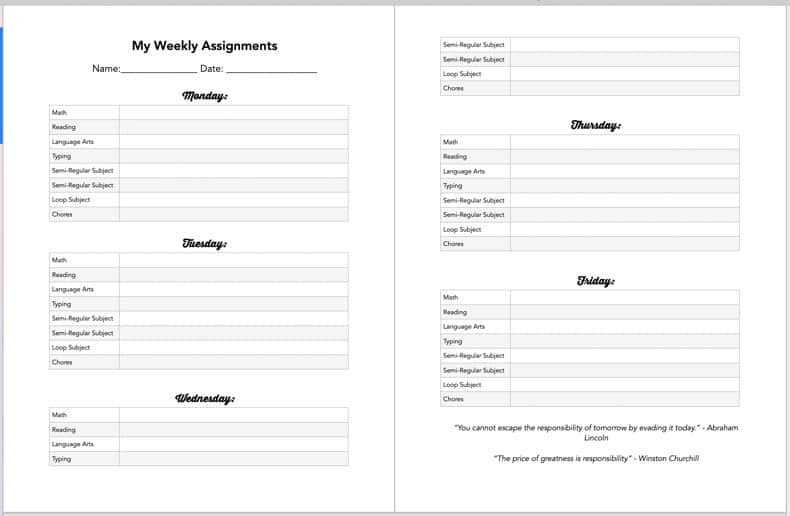This post gives a detailed outline of our homeschool plan for the upcoming school year. Find links, curriculum recommendations, and inspiration – plus two free printable student planner pages that I use for my own kids.

I’ve been homeschooling my kids since before Covid-19 made it cool. This might be the very first time in my life that I am ahead of a trend. Ha!
Currently, homeschooling is a big topic for the upcoming year where public and private school plans are ambiguous and many parents are opting to just homeschool instead. Since I’ve been asked a few times about my curriculum choices for various subjects, I figured I should go ahead and compile it all into one big ol’ (hopefully) helpful blog post!
There are several main philosophies of homeschooling (I first fell in love with Charlotte Mason style many years ago, and have evolved from there). Today, I’d describe my homeschool planning style as thoroughly eclectic. I draw inspiration from several styles (plenty from CM), but ascribe to none as a purist. I pick and choose my resources and curriculums subject-by-subject, and year-by-year.
Our Homeschool Journey
Much like many of you, our homeschooling journey has had some twists and turns. I started out feeling certain that I wanted to homeschool, but when our oldest was in Grade 1, I started having doubts. Homeschooling felt so utterly overwhelming and endless in its options that I had a serious case of analysis paralysis.
In addition to that – I was one of those kids who had a rosy, wonderful time in elementary school. The work was easy and fun, the teachers loved me, and I excelled. I wondered if I was making my kids miss out on something great.
We ended up sending our son to public school for Grade 2, and by this time our daughter was Kindergarten age. They enjoyed it for the most part, and we continued for the next year (Grades 3 , 1, and JK for our third-born), and the year after that (Grades 4, 2, and K).
However, while our oldest was in Grade 4, previous minor concerns became larger and it became abundantly clear that public school was not a good environment for him. When he was a bit younger we had taken him to an educational psychologist who identified him as “twice-exceptional”, which means that he is both academically gifted as well as dealing with a learning disability. This is identified in several ways, such as by scoring in the 98th percentile in one area (visual-spatial), but the 10th in another (working memory). For us, this looks like giftedness + ADHD and anxiety. (For others, it’s other differences, like autism, dyslexia, or even physical disabilities.)
Sadly, public schools are woefully underfunded and unequipped to meet the needs of a child that doesn’t fit the average mold – especially the gifted child. (That’s a whole separate tangent – they are so often misunderstood.) Another piece that often accompanies this type of child is social difficulties. There was bullying involved on a daily basis, and it became clear that his environment was toxic for him.
By mid-December we gave the school notice and within 48 hours he was home to stay. We deschooled (no formal schoolwork for a time in order to allow decompression and re-orienting to a new way) for a good 6-month period, and the following fall our other kids stayed home too, making us a fully homeschooling family.
Starting Out With Homeschool Plans: Why I Made Chores a Focus
One of the things I was committed to doing as we started our homeschool journey a few years ago was to not rush things. It was essential to me to strive for a peaceful home, and that meant no overburdened mama, and no overwhelmed kids. Kids can’t learn in a chaotic and stressful environment, so that had to be our first priority.
I started out just doing one or two “academic” things a day (math and reading). In our first full year I considered chores and habits to be a big part of our main learning, with a minor in academics. This has proved to be one of the smartest things I could have done, and I highly recommend it!
With all of us at home most days it’s so easy for the mess to explode so quickly. And with me working part-time from home (this blog earns me a nice side income) I simply can’t be an entrepreneur, homeschool teacher, and housekeeper without it being a team effort!
In the last 2 years we’ve really nailed down our household chore zones, trained the kids to do chores properly, and stayed consistent with personal habits (like keeping everyone bathed and on track with daily responsibilities without me needing to nag too much).
My big kids (born in 2008, 2010, and 2012) all know how to clean the entire kitchen after a meal, mop, sweep, and vacuum floors, scrub a bathroom, do their own laundry, wash appliance fronts and cupboards, bake, and more. It was well worth the effort of training over the last few years. (And to be clear: their chores sound like a lot, but they aren’t spending hours a day scrubbing the house. Many hands make light work!)
Last year our routines were really humming along well so I added in more and more subjects and academic opportunities as the months went on.
Going In to Our 3rd Full Year of Homeschooling
This upcoming year I am adding even more. That’s not to say that I’m going crazy and overloading the kids with work – I’m still very mindful of making sure they have many free hours a day to play, read, relax, and create. A big part of the reason for enriching and broadening our subjects so gradually is because it’s a LOT of work on my end.
If you’re new to homeschool planning, I want to emphasize this one point. When you see seasoned homeschoolers talk about what they accomplish in a year, and feel bewildered as to how they do it – be encouraged that they didn’t start out on Day 1 with everything under control and humming along. It takes time, and most homeschoolers are always open to adding or dropping things along the way. That’s part of the beauty of homeschooling: freedom to go at your own pace – both student and teacher alike.
As a natural researcher and lover of knowledge, I have to fight the urge to become an expert on every little thing before I proceed, so it takes me a while to make my decisions on resources that I use. That being said – I’m including both our tried and true favourites here, as well as some options that are new to me that I’m planning to try. (I might change my mind on things as time goes on.)

Our Homeschool Plans for 2020-2021, Subject-by-Subject
Math
I started out with RightStart Math 7 years ago when I homeschooled our oldest for a year before sending him to public school. It wasn’t a good fit for us. Lots of people like it, but it requires a lot of hands-on teaching, and I didn’t want to do that. As a part-time WFH (work-from-home) mom, I pick and choose my heavily-involved teaching subjects very carefully. I’d rather outsource math as much as possible.
I then used Math Mammoth when we returned to homeschooling a few years ago, and it was fine (it’s a great option if you’re on a tight budget), but too workbook-ish for our tastes. Isaac’s difficulty with pencil work/handwriting (dysgraphia?) prompted me to search for online options, which led me to Beast Academy, which I absolutely love.
We use BA online (they have both online and offline/paper options) and I love that it’s challenging (it’s geared to kids who are bright, gifted, or good at math) and teaches critical thinking skills, not just rote memorization of math facts and equations. The word problems are killer sometimes, but they force the student to think through the math concepts and understand the why in addition to the how.
I also love that it’s all online and scored automatically. For each lesson they can get either 1, 2, or 3 stars, depending on how many questions they got correct. (Our rule is 2 or more stars or you re-do the lesson.)
My only role is as helper, which is hard enough for a non-mathy parent. (I signed up for my own account just to relearn the stuff from Grade 4 on because whoa – I’ve forgotten everything beyond adding, subtracting, and multiplying! Yikes!)
(We use it for all three school-age kids, and I absolutely love it.)
Language Arts
LA is actually several subjects together under one banner, so I’ll break it down since I’m using different resources here.
Quitting TGTB
First, a note on why I’m quitting The Good & the Beautiful: Until this year I have used TGTB, but I won’t be continuing with it. There are a few reasons for that:
- It feels too busywork-ish at times.
- I wasn’t impressed with their fine art teaching. The language arts levels are interwoven with geography and fine art study, but I had only heard of *one* of the artists we studied in the 2-3 years we spent with the curriculum. There were lots of really obscure choices at the expense of the famous greats. I’d have been happier if both types were covered.
- I found their writing instruction lacking. It’s heavy on the mechanics, but lacking in the art of good writing.
- I also found the curriculum as a whole to be heavily American nationalistic, which I found distasteful.
- I also find it heavily moralistic. It’s written by a Mormon but is written in a general Christian worldview using the KJV (i.e. nothing Mormon in particular about it). It’s not so much the particular morals that are taught, but more the overly preachy/moralizing way of presenting them. Some people love TGTB, but it wasn’t right for us.
Here’s what I am using:
Writing
I’ve been eyeing Brave Writer for a few years now and am really excited to start going deeper with the kids’ writing skills. One of my kids writes books for fun, one whines when I ask him to write a single sentence, and the other is somewhere in the middle. I believe that having excellent writing & communication skills is a huge advantage in life (for anyone), so I’m requiring all of my kids to work hard in this area.
I’m using The Writer’s Jungle as a foundation for myself to teach writing, and also using the stage-appropriate add-ons for each kid. (Jot it Down, Partnership Writing, etc.) I’m undecided on whether I’ll be also doing their grammar/mechanics program too, or maybe just taking a break from that this semester.
Side note: I found their website and various product offerings somewhat confusing, so feel free to comment below if you’re interested but unsure on what to buy.
Literature
Making my own reading list for each kid (a mix of classic literature and easier “fun” reads).
P.S. Share your kids’ favourites with me – we’re always looking for new books!
Poetry
We’ll cover poetry really casually – it’s on my list of rotating subjects in our loop, and I’ll mainly focus on reading poetry aloud and keeping it fun. We’ll include famous poems, favourite song lyrics, and silly poems. Goal: to foster an appreciation for the art of poetry before diving in to more serious stuff.
Memorization
I have memorization as a rotating subject in my loop schedule because I think it’s an important cognitive skill that spans all subjects. We’ll memorize things like:
- The continents
- Canadian provinces & capital cities
- Some Bible verses
- Some short poems
- Multiplication facts
- Our full address & phone number
- Months of the year

Geography
I have a hodgepodge of resources. I don’t have a set curriculum for geography this year, but I want to focus on making sure the kids are solid on the Canadian provinces and territories, and then branch out to world geography (countries). I’ll probably find free stuff on Pinterest as we go. I have this illustrated map of Canada for kids on our dining room wall.
History
We’ve been using Story of the World so far, and enjoying it for the most part. We bought the audiobook version which I prefer for our read-aloud time. (Yup, totally still counting it as a read-aloud.) I also bought the supplemental activities book, but I think it’s somewhat lacking in selection and creativity. The activities are often sort of lame for bigger kids (colouring pages) or just not something I’m interested in doing (setting up an archaeological dig in the sandbox).
This year we’re using a new-to-us curriculum called Curiosity Chronicles. It’s aimed at elementary kids, so will probably need some tweaking for my oldest (12yo) however I’m really excited by the supplemental activities that they have: timelines, interactive notebook-keeping, optional lapbooks, Minecraft activities (woohoo!) and more. I think my kids will enjoy it, and we’ll probably still listen to the SOTW audio as well, just because we all find it interesting and we’ll probably learn different details from each.
Note: CC is a religiously-neutral (secular) curriculum. While we are Christians ourselves, I don’t require all of my resources to be written explicitly from that worldview. The great thing about homeschooling is that you can teach your family values in a million different ways throughout your day/years.
Science
The Charlotte Mason philosophy (the style I first embraced when I started homeschooling) teaches that nature study is the only science that is needed in elementary because it is the foundation of all sciences. I’m not a Charlotte Mason purist by any means, though, so I always have an ear out for interesting-looking science stuff, plus my kids love all things science.
So far I’ve decided to go with two resources:
Nature Study
How to Teach Nature Journaling by John Muir Laws
At the time of writing this blog post, the PDF version is being offered for free on that site. I downloaded it and it is absolutely GORGEOUS and well done. I’m super excited about using it this year! Nature journaling is one of those things I’ve had on my to-do list for an embarrassingly long time, and this book looks like an absolute game-changer in that department. I love the level of detailed guidance!
Astronomy
Experience Astronomy (Elementary & Upper Level)
I’ve had this resource saved for a few months now and every time I look at the site I get more and more excited. When we moved to a rural setting back in 2019 we got super excited by all of the stars we saw so brightly in our sky one night when getting home after dark. (This doesn’t happen frequently when you have small children, ha!)
I downloaded an app called Skyview, which lets you point your phone at the sky while it identifies all of the stars, constellations, and planets. Now, every time we have a campfire in the backyard, the kids fight over using the app. I think this course will be perfect for encouraging that natural curiosity in astronomy!
Foreign Language
We have used Duolingo for years to keep plodding away at our French learning. It’s okay, but not amazing. I don’t see it getting us to full fluency.
As you may know, Canada is a bilingual (French and English) country, so everything on a federal level is bilingual. We happen to live just outside of our nation’s capital, which means being bilingual around here is the norm. We also happen to live in a very French community – we’re not far from Quebec, and the people in our small town and surrounding areas are majority francophone. Some (our neighbour’s 8yo) don’t even speak English yet. (She attends a French school.)
So, all of that to say: learning French is important to us. If our kids want to get part-time jobs in town in their teen years, they’ll have to be bilingual. As of right now, only Aliza (10) is fluent enough to communicate easily. She had 3 years in public school French immersion, and combined with a natural propensity for languages – she’s able to speak nearly fluently. (Her writing and grammar need work, but when she plays with the friends next door it’s exclusively in French.)
Unfortunately, the boys didn’t get to do French immersion, so they only know some basic vocab, and the same with Chris. I did French immersion for a few years growing up but am super rusty! Eventually we’d love to do classes or tutoring as a family to get us all fluent, but that’s not cheap.
If you have an amazing French-learning resource to recommend that’s inexpensive, comprehensive, and can cater to multiple levels of fluency – let me know!
Computer Skills: Typing & Coding
We’ve used the free version of Typing Club in the past, but I’m meh about it. If you have other suggestions, feel free to comment below. The kids practice typing skills several times a week. I feel that it’s an important skill that will make life easier in years to come.
Side note: I moved a lot during my school years and somehow missed out on any typing class at school. To this day I don’t type properly and it’s frustrating. I don’t want to let that happen to my kids.
For coding, we have a subscription to Tynker. My kids loved it at first but their interest has waned. I plan to take a closer look at the “assignments” they offer to help encourage them to work on the harder skills to get to the next level.
Coding is another one of those things that I believe will equip them well for their future. As our world becomes more and more technology-driven, I want my kids to have practical skills that they can use, even if it’s just a familiarity with tech and ability to interact with it with ease.
Music: Learning & Appreciation
Prior to the shutdown, my two middle kids took piano lessons with our great piano teacher who came to our house. Hopefully we can begin those again.
In addition, I bought this World’s Greatest Composers unit study from a homeschool blogger last year as an add-on for my assignment-loving daughter. We did a few lessons and then it fell to the wayside. I am going to restart it this year with all three big kids. It’s very thorough, and I think it’ll be fun!

Art: Learning & Appreciation
For practicing art skills, we’ll be using free videos on YouTube – of which there are plenty! I plan to try some sketching/drawing, watercolours, and some good ol’ Bob Ross painting videos.
For art appreciation, I am excited to dive in to the art resources (many of which are free!) on A Humble Place. Rebecca (an old blogging friend) has done such a lovely job on them, and she even has advice on her site on exactly how to do picture study. (Spoiler: it’s simple and not intimidating, even for newbies.)
Social Studies
I have social studies on my looping subjects rotation (more about looping below), and am still nailing down my approach. I am not using a curriculum – mainly because I don’t know of a good one. We’ll be starting the year by going through this book on Canadian government. See it on the Canadian amazon here.
My goal is to discuss these topics, using a variety of books, read-alouds, field trips, and projects:
- Civics: government and laws
- What it means to be a member of your local community
- What it means to have a voice in a democracy (voting, contacting your local elected officials)
- Main types of governments in the world, and how they differ from ours
- Cultures around the world
(We cover these things in an ongoing manner throughout the years, building in more detail as they get older.)
Faith/Spirituality
We have a number of contemplative/devotional-style books that are aimed at young readers. We’ll be going through those together, and I am also going to focus on weaving ideas from this book into our family life.
We’ll also include some Bible verses with our memorization list.
How We Use a Looping Schedule in Our Homeschool Planning
Whew! That was a rather long and intimidating list of subjects and resources. (If you weren’t intimidated whatsoever, you’re probably a seasoned homeschooler.)
So – the obvious next question is: how do we fit all of those things in to our daily rhythm?
Well first of all, we don’t. Ha! What I mean, of course, is that we don’t do every subject on a daily basis. Not even close. I assign core subjects daily: math, language arts (one thing, not all), literature, and typing, and the rest I place in a loop rotation schedule.
This year will be our first time following a more formal loop schedule. Previously I’ve embraced the concept without formalizing it, and I think I’ll appreciate the structure that this will give. I’m not naturally structured/scheduled, so if I don’t have plans and details in place I tend to let our days pass by in a haze of free time and go-with-the-flow.
Some of that vibe is needed (and it comes so naturally to me), but too much is detrimental to our overall goals. My more Type-A friends have the opposite struggle. Knowing your own personality is such a huge benefit as a homeschool mom – you can really zero in on which methods and tools serve to accomplish your goals best.
Here’s a glimpse at the loop schedule I created for this upcoming year:

How it Works
We start with Week 1, Day 1 (Monday). On that day, the kids do their core subjects, plus we do what’s on our looping rotation (music appreciation), plus what’s on our semi-regular rotation (history & faith).
The next day we do the same thing, only with the Week 1, Tuesday subjects, and then we continue along on the schedule until it’s done – all through the four weeks, at which point the loop starts over.
Again, to be very clear for those who are new to homeschooling: this type of schedule is not meant to take all day, nor is it meant to overwhelm. Some days will be more involved (a science experiment or nature journaling), and some will be less (baking cookies and calling it science, a simple reading assignment, listening to a piece of classical music).
On some days a loop subject will take an hour, whereas other days will take just five minutes.
The point is not to spend all day on formal academics (in fact, I intentionally avoid that). The point is simply to automate our desired frequency of engagement for our subjects so that I don’t have to constantly think about whether we’re covering everything.
The Daily Student Planner We Use in Our Homeschool
When I started homeschooling I searched online for planning tools. I found lots of free stuff for my planning and organizing, but very few resources for student planning – like assignment pages. So, I created my own.
My kids have their own daily planners. Last year we used paper duo-tangs, but they barely made it through a year of daily use in one piece. This year, I have a new binding machine that I plan to use for all of my print-at-home curriculum, as well as our daily planners for the kids (with plastic covers for durability).
Years ago, I was inspired by this blog post from Read Aloud Revival about the value of handwriting your kids’ assignments in a paper notebook. The concept totally resonated with me, but I needed to make a few changes.
Instead of using a totally blank notebook, I created a printable template to reduce the amount I had to handwrite each day. And instead of writing assignments every night, I assign a week’s worth every Sunday.
Last year my printable was fairly simple with days of the week and blank lines to write on. This year I updated it to be more detailed, and I’m looking forward to trying it out.
Simple Version:

As you can see, this was a 7-year-old boy’s planner. It’s not instagram-pretty, but it WORKED. Every day he was responsible to complete and check off assignments before getting “signed off” (initialed by me) for the day.
This version is super flexible and open-ended, but gives just a little bit of structure beyond a blank notebook.
Detailed Version:
This year I created an upgraded version of our daily planning sheets that has our loop scheduling built in.
Here’s what it looks like:

Want to download the PDF printables for your personal use? They’re available for free to my email subscribers. Sign up below and they’ll land in your inbox within seconds:
[cboxarea id=”cbox-BxAdncrTJknum7Fs”]Homeschool Teacher Planning
This past year I’ve worked on creating my own printable teacher planner because I couldn’t find one that felt like a perfect fit for me. There are lots of planners out there that look great, but I’m pretty specific in what I want (and don’t want or need) in mine. The one I created is working well for me so far. (I may share it here if there’s interest.)
Do you have a homeschool teacher planner that works well for you? If you have one that you just absolutely love – share in the comments section below.
Last Thoughts
Homeschooling is an ever-evolving process that is fluid from year to year. That’s part of the beauty of it – you can flex and change stuff that doesn’t work, and you can try new things whenever desired.
The resources I listed above represent just a fraction of what’s available. Homeschooling is easier than ever today, and your main problem will probably be narrowing down your options!
If you enjoyed this you may also be interested in my post on Indoor Gross Motor Activities for Kids who NEED to Move Their Bodies! (ie All Kids!!)

























Faith
Hi Beth! I’m homeschooling my 3rd and 4th graders this year! Love this post and would love a copy of your teacher planner! I have tons of veteran homeschool friends that I’ve been bugging all summer with questions, and I’ve been talking with the kids quite openly about what they want their homeschool life to look like. I love your ideas of chores and a deschooling time (feels like we’ve already gone through that here since they haven’t had formal in-person school since March 13!) I’m looking forward to this year, but most nervous about managing my own time (also have a busy and smart 1 year old) and not letting things spiral out of control and end up with completely feral, rabid children! haha!
Beth
Hi Faith, sorry I missed this comment somehow, but I got your email and replied. 🙂 I am cheering you on from afar and I know you’ll do great! There will be hard days, but overall your care and love is evident, and that’ll carry you through. xo
Rachel Diehl
For social studies
https://aroundtheworldstories.com/
Original audio stories for kids (but interesting enough for mom too) PLUS extension activities/ info for each story. Usually 4 stories for each country they have done. Love these!
Love the idea of having 2 loop schedules!